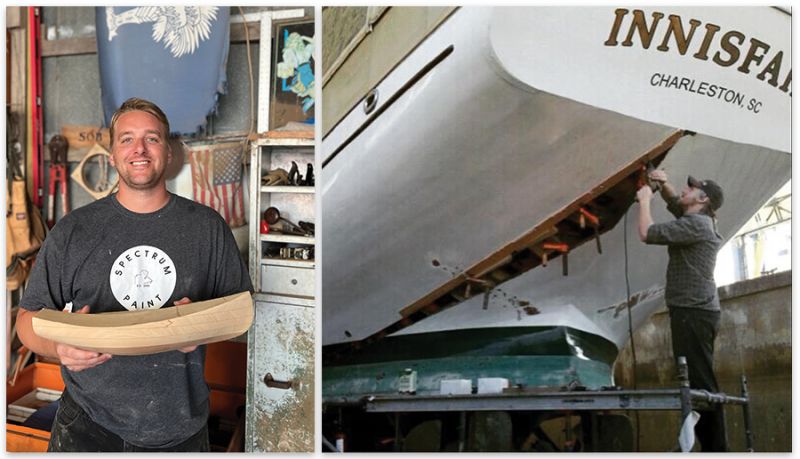The Sons of Bayne owner discusses the craft

(Left) Coulson Bayne in his shop with a half hull model; (Right) Bayne planking the hull of the classic yacht Innisfail in 2011.
A time traveler who opens their eyes in Coulson Bayne’s Mount Pleasant workshop would be hard-pressed to identify the year in which they’ve landed. Most of the tools—hand planes, braces, chisels, manual drills—predate the 36-year-old boatbuilder who uses them. “Wooden boatbuilding isn’t ever going to change that much,” says Bayne. “I settled on this because if computers ever fail, we’re still going to need people who can build stuff.”
Bayne also had a familial inclination toward the trade. His father, Mark Bayne, is a nationally respected shipwright who built the Spirit of South Carolina tall ship, launched in 2007. “My dad would leave me a certain amount of plywood and hardwood and tell me to build something,” says Bayne, recalling a holder he made for his CD player and CDs. He was a regular at his dad’s shop, sweeping the floor and mixing batches of wood glue. In eighth grade, he and Mark competed at Georgetown’s Wooden Boat Challenge, a four-hour, two-man race to build a functional skiff.

(Left) Before cutting patterns for a boat, Coulson Bayne makes a full-scale line drawing of the vessel; (Right) A set of chisels.
But after high school at Bishop England, Bayne hesitated to follow his father’s path. The Spirit project was underway, and despite his awe for the massive wooden skeleton slowly taking shape in a downtown field, the scale of that build felt “unattainable at the time.”
“When you’re young, you don’t want to do what your old man does,” says Bayne. Still, his inherent skills landed him jobs at several high-end cabinetmakers. Before marrying his wife, Lisa, he built furniture at Brooks Custom Woodwork on Sullivan’s Island. With her encouragement, he struck out on his own, leasing a shed from the Lowcountry Maritime School in Mount Pleasant.
In five years operating as Sons of Bayne Boatworks, an homage to his father and grandfather (a Navy veteran), he’s built a 25-foot catboat, a 16-foot rowing skiff, and a pair of 23-foot Point Comforts modeled after a Chesapeake Bay deadrise, as well as made countless repairs. “My old man always said that you build boats for the glory, but you repair them for the money,” Bayne laughs.
Sons of Bayne’s largest project to date is now underway—a 34-foot sport fisher with a Carolina flare bow and tumblehome stern. Bayne is also a recent father. His son, Nico, was born in March. And even as he builds his own family and reputation in the wooden boat world, he knows that support is just a phone call away.
Tools of the Trade - Boatbuilding essentials haven’t changed much in the last century